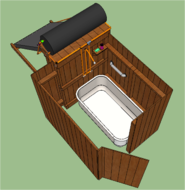Thermosiphon
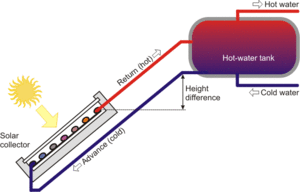
Thermosiphoning, also known as thermosyphoning, is considered to be an appropriate technology. This process utilizes natural, renewable resources and the basic laws of thermodynamics to create movement of a heated supply of air or water. The energy source for this process is solar radiation (or any other source of heat). The energy of the sun is captured in a solar collection device and is transferred to either air or water via conduction. The entire process may be explained by the thermosiphoning effect: when air or water is heated, it gains kinetic energy from the heating source and becomes excited. As a result, the water becomes less dense, expands, and thus rises. In contrast, when water or air is cooled, energy is extracted from the molecules and the water becomes less active, more dense, and tends to "sink." Thermosiphoning harnesses the natural density differences between cold and hot fluids, and controls them in a system that produces natural fluid movement. Several systems based on this technology are currently available, and may be read about in greater detail within the following text.
The principle of the thermosyphon system is that cold water has a higher specific gravity (density) than warm water, and so being heavier will sink down. Therefore, the collector is always mounted below the water storage tank, so that cold water from the tank reaches the collector via a descending water pipe. If the collector heats up the water, the water rises again and reaches the tank through an ascending water pipe at the upper end of the collector. The cycle of tank → water pipe → collector ensures the water is heated up until it achieves an equilibrium temperature. The consumer can then make use of the hot water from the top of the tank, with any water used is replaced by cold water at the bottom. The collector then heats up the cold water again. Due to higher temperature differences at higher solar irradiances, warm water rises faster than it does at lower irradiances. Therefore, the circulation of water adapts itself almost perfectly to the level of solar irradiance. A thermosyphon system's storage tank must be positioned well above the collector, otherwise the cycle can run backwards during the night and all the water will cool down. Furthermore, the cycle does not work properly at very small height differences. In regions with high solar irradiation and flatroof architecture, storage tanks are usually installed on the roof.
Thermosyphon systems operate very economically as domestic water heating systems. The principle is simple, needing neither a pump nor a control. However, thermosyphon systems are usually not suitable for large systems, that is, those with more than 10 m² of collector surface. Furthermore, it is difficult to place the tank above the collector in buildings with sloping roofs, and single-circuit thermosyphon systems are only suitable for frost-free regions.
Underlying physics[edit | edit source]
Thermodynamics is the study of energy.
- First law of thermodynamics - States that energy may be changed from one form to another, but cannot be created or destroyed. Energy is always conserved.
This law may be applied to the movement of water in thermosiphoning system: Energy from the sun is directed and transferred (via conduction and convection) to either water, air, or another medium of choice. This natural process of heating eliminates the need for external energy sources such as fossil fuels or electricity.
- Second law of thermodynamics - States that in all energy exchanges, if no energy enters or leaves the system, the potential energy of the state will always be less than that of the initial state. The net return of a system is always less than that of which was initially put in.
Energy is always conserved, however energy (or heat in this case) may often be lost in a given system (thermosiphoning) as heat. Adding insulation with appropriate R values to the system and its plumbing may greatly reduce heat loss, and thus increase efficiency.
- Planck's Law - The wavelength of radiation emitted from a surface is proportional to the temperature of the surface. Energy transferred as a result of temperature differences between two objects. Dark objects absorb heat, while light objects reflect.
Darkly colored collection plates within the solar collector will aid in increasing solar absorption, thus increasing the amount of heat available to heat water or air in thermosiphoning. In contrast, reflective or lightly colored piping and storage tanks should be utilized as the light colors will help to reduce heat radiation out of the system.
Passive water heating[edit | edit source]
The passive thermosiphoning of water is the process of heating and moving water within a system without the need or use of electricity. This process functions by utilizing natual phenomena such as solar energy, gravity, and an available water source. A solar collector, piping, and a water tank are materials required for the heating process. The flow of water is distributed into, within, and out of the solar collector. Cool water enters the bottom of the solar collector where it is then heated via convection by solar radiation. When water is heated it becomes less dense than cooler water, expands, and then rises (flows) through the piping. The heated water exits the top of the solar collector naturally. The cooler and more dense water sinks and remains within the solar collector until it is heated. As the cool water is heated, it expands, rises, is pushed out of the top of solar collector, allowing cool water to flow into the solar collector. This process continues naturally until the temperature of the water reaches an equilibrium with solar radiation input.
Two types of thermosiphon water exchange systems are currently available: the close-coupled system, and the gravity-feed system.
Close-coupled system[edit | edit source]
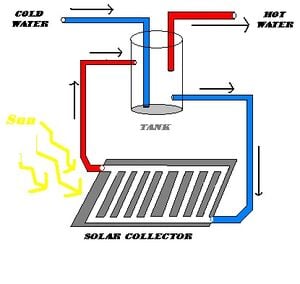
Close-coupled systems function on the same principles of passive thermosiphoning mentioned above. The storage tank of these systems must be placed above the solar collector to utilize the water circulation driven by the passive thermosiphoning process.
Materials[edit | edit source]
- Solar Energy
- Solar Collector
- Piping
- Insulation
- Water
- Storage Tank
- Strong roof or other support system
Cost[edit | edit source]
- 2007 research suggests that passive thermosiphon water heaters may range from $500 to $6,500. Pricing may vary due to tank size, solar exposure, and geographical location
- Many countries, states, and utility services provide incentives for renewable energy participation
Pros[edit | edit source]
- Non-polluting
- Energy Savings - No electricity needed for passive thermosiphoning
- Cost Effective
- Space saving - (i.e. indoors)
Cons[edit | edit source]
- Tank exposure to external environmental condition may reduce efficiency, depending on geographical location
- Aesthetics - May be considered visually unpleasing
- Strong support structure needed (i.e. roof)
- Not suitable for extremely cold climates
- Location - must be positioned in an area with suitable solar exposure (i.e. south side of desired area)
Gravity-feed system[edit | edit source]
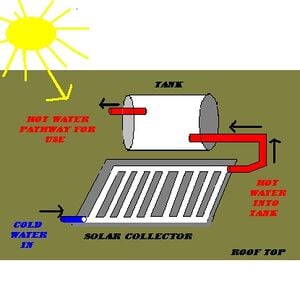
Gravity-feed systems utilize the same principals of passive thermosiphoning as does the close-coupled system, however placement of the tank differs. Tanks are installed horizontally into a roof, which is often located directly above the solar collector. Once needed, the heated water within the storage tank takes the path of least resistance and moves via gravity down into the desired location. Gravity-feed systems require more piping/plumbing to distribute the heated water, and this factor should be taken into consideration when installing or purchasing a thermosiphoning system.
Materials[edit | edit source]
- Solar Energy
- Solar Collector
- Piping
- Insulation
- Water
- Storage Tank
- Strong roof or other support system
Cost[edit | edit source]
- Gravity-feed systems are typically the least expensive passive thermosiphoning water heaters
- 2007 research suggests that the cost may range from $400 to $5,500 (not including the cost -if applicable- of installation). Pricing may vary due to tank size, solar exposure, and geographical location
- Many countries, states, and utility services provide incentives for renewable energy participation
Pros[edit | edit source]
- Non-polluting
- Energy Savings - No electricity needed for passive thermosiphoning
- Cost Effective
- Space savings - (i.e. indoors)
- Aesthetics - (Horizontal tank placement)
Cons[edit | edit source]
- Plumbing and piping add additional costs to the system
- Aesthetics - May be considered visually unpleasing
- Strong support structure needed (i.e. roof)
- Not suitable for extremely cold climates
- Location - must be positioned in an area with suitable solar exposure (i.e. south side of desired area)
Active water heating[edit | edit source]
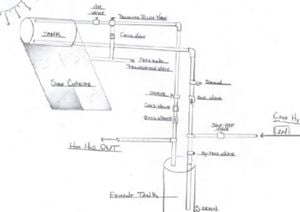
Active solar heating systems, also known as pump systems or split systems, function on the same basis of the thermosiphoning effect, however active systems utilize an energy source other than solar energy to help drive the process. This system installs only the solar collector on the roof, while the storage tank is installed on the ground or anywhere else below. These active water heating units require some external form of energy to pump the water throughout the system. By utilizing additional energy, these active systems are less cost efficient than passive systems.
Materials[edit | edit source]
- Solar Energy
- Solar Collector
- Electrical energy
- Electrical pump
- Additional piping
- Insulation
- Water
- Storage Tank
Cost[edit | edit source]
- 2007 research suggests that active thermosiphon water heaters may range from $1,200 to $10,500. Pricing may vary due to tank size, internal piping requirements, solar exposure, and geographical location
- Many countries, states, and utility services provide incentives for renewable energy participation
Pros[edit | edit source]
- Money Savings
- Cost Effective
- Aesthetics - Storage tank not placed on the roof
- Greenhouse gas reduction - If insulated properly, it has the potential of polluting as little as passive systems.
Cons[edit | edit source]
- Uses more energy than a passive system
- Requires more maintenance than a passive system
- Heat loss - during the transfer from the solar collector to the storage tank below
- Pollutes some - from the electrical usage
- Location - must be positioned in an area with suitable solar exposure (i.e. south side of desired area)
Passive air exchange[edit | edit source]
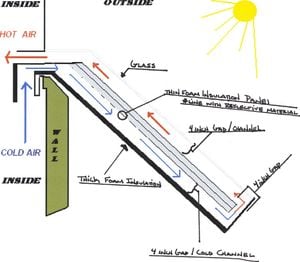
An example of a passive solar thermal heating system method is Thermosiphon Heat Exchange. It is based on the principle of natural convection, in which air or water is circulated in a vertical closed-looped circuit without using a pump. Cool air indoors travels through a vent and is directed into an opening in the bottom of a solar collector. The air contained within the solar collector is then heated by the sun via solar radiation. Cool air is dense and will sink, while warm air is less dense and will rise. As the air heats up within the solar collector, it becomes less dense than the cooler air and rises. The warm air rises out of a vent in the top opening of the solar collector, moves into the desired area (i.e. indoors), and is replaced by cooler air. This air exchange process will continue until the indoor air temperature reaches an equilibrium with the temperature outdoors.
Materials[edit | edit source]
- Solar collector - The bigger the solar collector, the better.
- Frame
- 6 vertical 2-by-6-inch boards - Sideboards
- 2-by-6, and a 2-by-8 boards - Top sill
- Lag screws - Recommended, but not necessary for attachment
- Glaze
- Corrugated polycarbonate panels
- 10 panels - 26 in wide by 8 ft high
- Pairs of panels overlapped over 1-by-1-in vertical wood strip - Makes 4-foot-wide panels for each bay
- Ultraviolet-resistant coating - Apply to sun-facing side to extend longevity
- Solar absorption plate
- 2 layers black metal window screen - Attached across the top and bottom of bays
- Vents
- Holes cut through building's siding - Plastic flaps will prevent back flow of air through upper vents at night.
Cost[edit | edit source]
- 2007 research suggests that passive heat exchangers may range from $55.00 to $400. Pricing may vary due to size of collector/s, insulation of area to be heated, solar exposure, and geographical location.
- Many countries, states, and utility services provide incentives for renewable energy participation
Pros[edit | edit source]
- Low cost
- Energy saver
- Pollution reduction
- May be used to cool electronics
Cons[edit | edit source]
- Increased maintainence - (i.e. covering during times of low solar radiation)
- Geographical location may alter effectiveness
- Requires manual closing of back draft dampers at night
- South facing installments preferred
Related projects[edit | edit source]
References[edit | edit source]
- National Renewable Energy Laboratory (NREL) Dynamic Maps, GIS Data, and Analysis Tools- Solar Maps (2007) Available: http://www.nrel.gov/gis/solar.html
- Citarella, Joe. "Thermosyphons - Better Approach to CPU Cooling?" Overclockers. 5 August 2005. http://web.archive.org/web/20080421004505/http://www.overclockers.com:80/articles1246/
- Reysa, Gary. "Build a Simple Solar Heater" Mother Earth News. January 2006 http://www.motherearthnews.com/Alternative-Energy/2006-12-01/Build-a-Simple-Solar-Heater.aspx
- "Part 2: A Tour of Renewable Energy Applications." http://web.archive.org/web/20060513045333/http://www.unepti.e.org/pc/tourism/documents/energy/11-26.pdf
- Mirmov, N. I., Belyakova, I. G. "Heat liberation during vapor condensation in a thermosiphon." Journal of Engineering Physics 43(3), pp.970-974, 1982.
- Design and Performance of a Compact Thermosyphon. Aniruddha, P., Yogendra, J., Beitelmal, M,Patel, C., Wenger, T. Woodruff School of Mechanical Engineering. 2002. http://www.hpl.hp.com/research/papers/2002/thermosyphon.pdf
